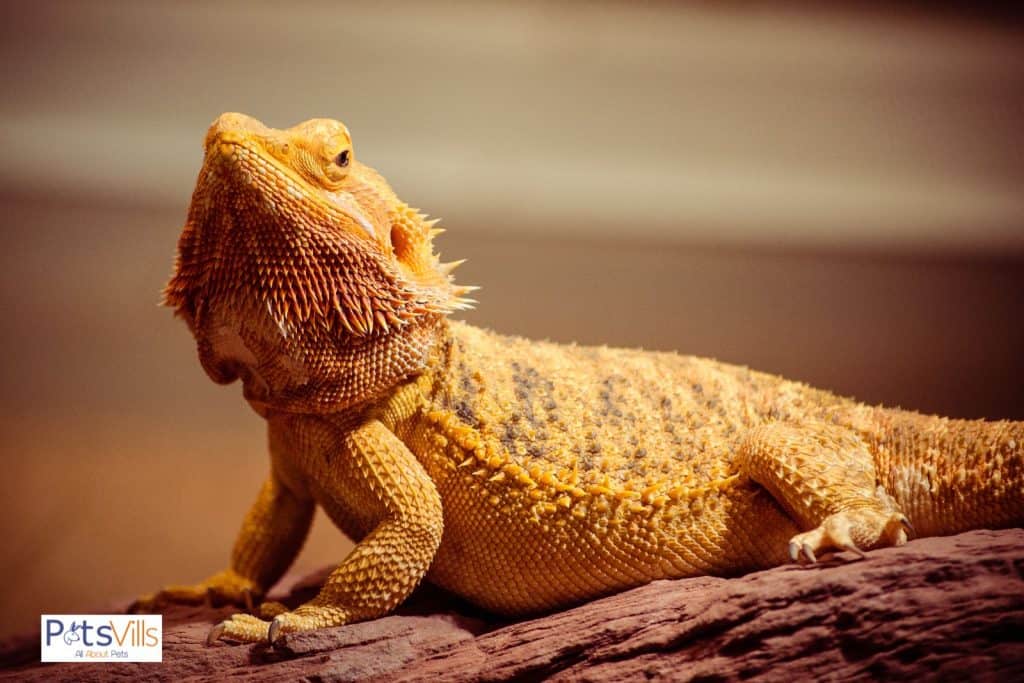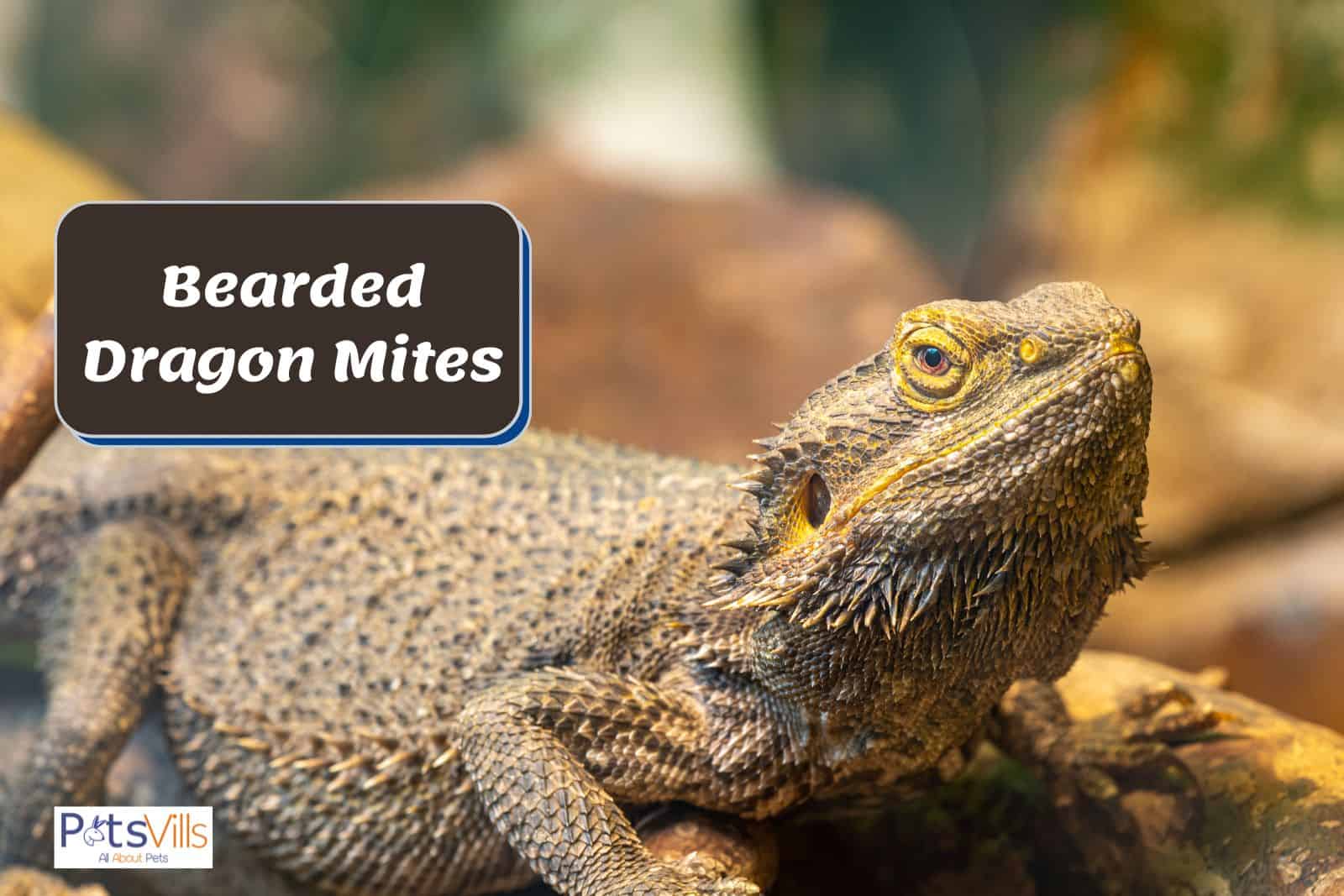The mention of bearded dragon mites will make any beardie owner shake in fear. It’s not something any owner wants to deal with or experience.
But it’s vital to know everything about these gross pests. Then, if they infest your beardie’s habitat, you can eradicate them quickly.
So read on, and I’ll teach everything needed to make these pests go away quietly.
Table of Contents
Quick Summary
- Bearded dragon mites are tiny parasites that can use beardies as hosts. They’ll appear as tiny red/brown/black dots, often located near the eyes or ears.
- Common symptoms include an abundance of dead skin, lack of appetite, noticeable ashy dust on a beardie’s entire body (mite poo), and lethargy.
- Eliminating mites on your beardie often requires prescribed medication. But sometimes, a bath with warm water and Betadine can get the job done.
- Owners must also thoroughly clean the beardie’s tank and surrounding areas.
What Are Bearded Dragon Mites?
It’s vital to start by outlining what exactly are bearded dragon mites. How else are we supposed to prevent or eliminate them without knowing the basics?
So the first thing to understand is that mites are tiny external parasites attached to beardies. The mites will then use your bearded dragon as a host.
In fact, beardies are prone to “several types of “internal parasites and mites” (1). Think about these mites as a dog owner would see fleas or lice.
They’re tiny nuisances that can make your life a horror show. If you’re a visual learner, here’s a video showing what mites and other common issues look like on beardies.
Where Are Mites Found on Bearded Dragons?
Mites aren’t overly common in beardies. But if your beardie does have them, these external parasites will usually pop up in one of these areas:
- Near the eyes and ears
- Under larger scales
- Skin folds
- Fecal matter
- Back and front legs
So I’d suggest remaining vigilant of these areas when checking on your beardie. As a result, it’s always better to catch a mite infestation before they get out of hand.
Types of Bearded Dragon Mites
Most people don’t realize bearded dragon mites aren’t all the same. There are four common types that could cause your beardie problems:
- Snake Mites: These types appear as brown or black mites near hidden or damp parts on beardies. If a reptile does suffer from them, it’ll often be a snake mite infestation, as they’re the most common mites on captive reptiles (2).
- Harvest Mites: These bright-red mites are the least particular regarding feeding. After all, they’ll attach to almost any host, ranging from birds to humans.
- Storage Mites: The most disgusting type, as they’re often found in the host animal’s feces. They’ll result from a problematic food source, such as mite-infested crickets.
- Pterygosomid Mites: These red/orange-colored mites are known for primarily infecting lizards.
Is your beloved bearded dragon suffering from sores? Don’t fret! Check out our article on ‘homemade remedies for bearded dragon’s sores‘ to learn some easy and effective ways to help heal your pet and get them feeling better in no time!
How Do Bearded Dragons Get Mites?
The origin of bearded dragon mite infestations can come from several places. But most infestations stem from an owner not taking hygienic measures.
For instance, a bearded dragon may get mites from sharing an area with another infested reptile. It could also come from dirty enclosures or recently bought mite-infested supplies.

So if you see mites on your beardie, paying attention to these causes is essential. It’ll help locate what’s driving the issue when you start the treatment process.
What Are the Symptoms of a Mite Infestation?
Knowing the symptoms of a mite infestation is also pivotal to dealing with one. It’ll offer a quicker avenue to stop one in its tracks.
Here’s a quick list of what symptoms a bearded dragon with mites may present:
- Small red, black, or brown dots around their eyes, ears, and other foreparts
- Rubbing
- Itching causes dead skin
- Loss of appetite and weight loss
- Ashy dust present all over their bodies (also known as mite poo)
- Lethargy
- Excessive time spent soaking in water (3)
READ MORE: Why Do Lizards Keep Their Mouth Open?
How Do You Treat a Bearded Dragon With Mites?
The first thing to do whenever encountering a mite is to visit your reptile vet. It’s the best treatment option at your disposal against these pests.
If you want a household treatment, some people swear by Betadine and a warm bath full of clean water (4). Using Betadine will be a simple 4-step process:
1. Remove Your Beardie From Their Tank
You’ll need to locate a safe place for your beardie while cleaning his habitat. A small extra tank or any easily portable container would be ideal.
But it’ll need to be thrown away or cleaned thoroughly later.
2. Make Your Beardie’s Betadine Bath
The first step will be mixing Betadine’s antiseptic solution with warm water. You’ll want to mix it until a light brown color appears, similar to muddy water.
3. Proceed to Bathe Your Beardie
Once it’s properly mixed, pour the bath water on their body. Getting it on as much of their body as possible is essential.
Don’t submerge your beardie unless necessary. It’s much better to pour it over them to avoid any issues.
If done correctly, the water will remove those pesky mites. You can expect the betadine to deal with any infections from the mite bites.
But it’s crucial to stop your beardie from drinking the water. So I’d advise trying to give him some water before adding in Betadine.
Also Read: Can You Put a Bearded Dragon in Water?
4. Use a Cloth to Apply More Solution
Once the bath is done, dab a cloth into a diluted betadine/water solution. Don’t use the bathwater but another container.
Rub the cloth all over your beardie’s body, including around the ears and neck. Avoid getting too close to the eyes, as it can be dangerous.
Give the solution ten minutes to sit on your beardie and wash it off thoroughly.
How to Clean Out Your Beardie’s Habitat?
It’s also worth noting that your dragon isn’t the only one suffering. You’ll need to address everywhere else the mites have spread, like its habitat and surrounding areas:
- Start by targeting the habitat’s surrounding areas. Use a pet-safe disinfectant/vacuum all the surfaces, rugs, and fabrics in these locations.
- The next step is moving into the bearded dragons’ tank and cleaning it. Honestly, it’s even more essential as your dragon spends most of its time there.
- You’ll want to begin by throwing all the non-disinfectable items out of your dragon’s entire tank. It’ll include the substrate and wooden branches/core bark.
- Proceed to use some hot, soapy water and clean the entire glass tank. Of course, it won’t be enough, so double down by using a bleach/water solution.
- Let the tank breathe for 10 to 15 minutes, and rinse it with hot water cleanly. Plus, be careful to clean all the lights within their tank.
- Soak any toys in a bleach solution for several hours and let them air dry. The drying process will take another couple of hours.
- Obtain a pesticide strip and place it in the tank with it completely closed. You may even need to line the tank with tape to ensure no air gets in during this process.
- Let the tank sit for several hours, and then let the tank air out outside or near a window. Again, this airing out process will take another few hours.
- After it completely aired out, your dragon can return to its tank. Keep an eye on them for the next couple of weeks. I’d also recommend using paper towels as a substrate to see if any mites are left behind.
How to Prevent a Mite Infestation?
I’d imagine anyone reading this article is now terrified of a mite infestation. Due to this, I thought it would be wise to discuss a few prevention methods.
Each of these precautions will help ensure this horrible experience never happens:
1. Regular Monitoring
Nothing can help prevent an infestation more than monitoring. Anyone who regularly inspects their dragon has a better chance of catching the mites.
If you catch them, it becomes much easier to prevent severe breakouts. It’s just a simple matter of checking the habitat and your favorite lizard from time to time.
2. Quarantine New Beardies
As I mentioned earlier, these mites often travel from beardie to beardie. So it’s necessary to separate all new ones for some time to ensure they’re free of parasites and mites.
You can bring them out of quarantine after a vet gives them a clean bill of health. Otherwise, you’re just playing with fire.
3. Don’t Buy Beardies From Untrustworthy Sources
Sadly, many pet breeders or sellers are very untrustworthy. They don’t feel any remorse about selling pets with mites or other medical problems.
Potential owners must research before getting a new beardie or any pet. To prepare for it, you must understand what you’re getting from the animal.
4. Never Handle Reptiles at Pet Stores or Expos
Avoiding handling reptiles or any animals at pet stores or pet expos is vital. These places are notorious for being less than reputable.
If you do, it could spread the mites picked up from handling these reptiles onto your beardie. It’s just a much better idea to avoid them altogether.
Also Read: How Long Do Bearded Dragons Live For?
FAQs
Can humans get reptile mites?
Humans can get reptile mites when in close contact with infested reptiles. These mites can cause severe human diseases, most notably botulism and salmonella.
Conclusion
Overall, bearded dragon mites are external parasites with bad intentions. But you can keep them away by routinely checking your beardie and their habitat hygiene.
It should be more than enough to keep your beardie mite-free. However, anyone who does detect an infestation should contact their vet immediately.

So, did you check if your bearded dragon is safe from the mites? Let us know in the comments section!
Resources:
- 1. Bearded Dragons [Internet]. Bush Heritage Australia. Available from: https://www.bushheritage.org.au/species/bearded-dragons
- 2. Snake/reptile mite (Ophionyssus natricis ) – Biological Services, Australia [Internet]. biologicalservices.com.au. [cited 2022 Oct 13]. Available from: https://biologicalservices.com.au/pests/snake-reptile-mite-92.html
- 3. Parasitic Diseases of Reptiles – Exotic and Laboratory Animals [Internet]. Merck Veterinary Manual. Available from: https://www.merckvetmanual.com/exotic-and-laboratory-animals/reptiles/parasitic-diseases-of-reptiles
- 4. Betadine (Povidone-iodine) | Betadine [Internet]. Betadine (Povidone-iodine) | Betadine. Available from: https://www.betadine.com/

My name is Ben Roberts, and I absolutely love animals. So, naturally, I love writing about them too! As far as my animals, I have a Pit-bull, a Beagle-lab mix, a Chihuahua, and one old cat. Each one of them provides me with a new adventure every day. And the best part is they’re all best friends. Well, except the cat when he gets a little annoyed.
FIND HIM ON: FACEBOOK and TWITTER.
Read his latest ARTICLES
Learn more about Benhere


